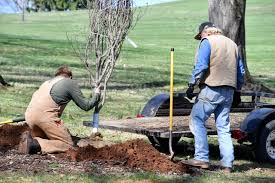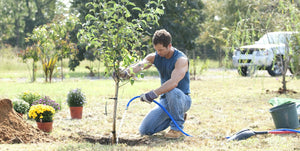
Tree Care and Common Misconceptions
We brainstormed up some common tree care misconceptions within the horticulture industry that I would love to clear up! Feel free to comment, e-mail us, or follow our other interactive websites or find us on Facebook.
1. Is it too late to plant a tree?
According to Ohio Buckeye Extension, “the biggest misconception in landscaping is people think they can’t plant in the summer, they only can plant in the spring or fall. Actually, the trees can only be dug in the spring before they leave out or after the fall if we have had one or two frosts”. You can plant a tree at anytime!
2. Should my tree be planted with the burlap sack and steel cage still on it?
Affordable Trees purchased biodegradable material, so leaving on the material is not harmful and actually proves to be beneficial. Iowa State University says, “If the root ball is exceptionally sturdy, all burlap, sisal and synthetic twine, and the wire basket can be removed before backfilling begins, however, removing these materials at this stage may result in the loss of root ball integrity and cause root damage.” The burlap and cage promote sturdy root growth and help keep the tree stable in the ground.
3. Should I mulch or add topsoil back on top of the tree?
One very common question is why mulch is so vital to the survival of your newly installed tree? According to North Carolina State, “Mulching trees and shrubs is a good method to reduce landscape maintenance and keep plants healthy. Mulch helps conserve moisture --- 10 to 25 percent reduction in soil moisture loss from evaporation. Mulches help keep the soil well aerated by reducing soil compaction that results when raindrops hit the soil. They also reduce water runoff and soil erosion. Mulches prevent soil and possible fungi from splashing on the foliage ---- thus reducing the likelihood of soil-borne diseases. They help maintain a more uniform soil temperature (warmer in the winter and cooler in the summer) and promote the growth of soil microorganisms and earth worms.” I also personally think mulching around the tree gives it a nicer look and helps alleviate the pain of mowing beneath the tree. On the flip side, adding topsoil can “can reduce the movement of oxygen to tree roots, causing them to die”, according to Iowa State University.
4. Raising the ball above grade
According to Iowa State, “the depth of the planting hole should be approximately two-thirds of the height of the root ball. When placed in the hole, the top one-third of the soil ball should be above the surrounding soil”. With Indiana’s clay soil, it is important to promote the drainage of water. The a major killer of trees is kindness. Placing trees above grade will help prevent over watering.
5. I have an “irrigation” system, isn’t that enough?
I often find it to be the case that tree owners with irrigation systems tend to have watering issues. Irrigation systems are designed for turf, shrubs, and shallow-rooted plants, all of which have different requirements than a newly installed tree. If an irrigation system is in place, make sure you are still checking soil conditions and adding or prolonging watering sessions. If watering is an issue, I recommend investing in a tree gator.
6. Should I amend the soil?
“Contrary to popular belief, soil removed from the planting hole is the most appropriate backfill material. Soil amendments like peat moss, ground bark, and composted manures mixed with the native oil and used as backfill have not proven beneficial to tree establishment. In fact, studies have shown tree root systems in amended soils remain confined to the amended soil in the planting hole, while trees planted without the "benefit" of soil amendments developed roots far beyond the original planting hole. And on poorly-drained sites, soil amendments can collect too much water. Because amended soil has greater pore space than surrounding clay soil, water will move into it preferentially.”
Good luck with your tree care!


